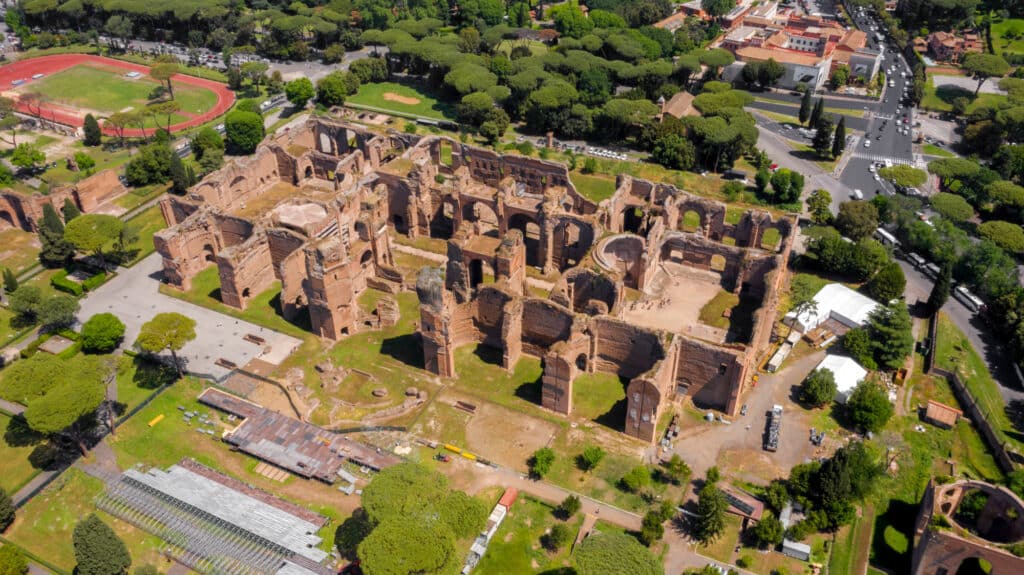
The entrance fee to Baths of Caracalla is 14.00 € per adult. This fee provides access to the entire complex, including the central hall, frigidarium, tepidarium, and caldarium. Visitors can also explore the stunning gardens, where they can relax and enjoy the beautiful surroundings.
If you are an EU citizen between 18 and 25 years old or a teacher/professor from the EU, you can enjoy a reduced admission fee of 2.00 €. This discount is a great opportunity for students and educators to learn more about the historical significance of the thermal baths and their impact on Roman society. Baths of Caracalla also offers free admission to visitors under 18 years old. Children and young adults can explore the baths and gardens without any cost, making it an excellent destination for families and school groups.
The Baths of Caracalla are typically open to the public from 9:00 am to 6:30 pm. A visit to the Baths of Caracalla can take anywhere from 1.5 to 3 hours, depending on your level of interest and the amount of time you wish to spend exploring the site. Guided tours, which provide more in-depth information about the site’s history and architecture, may take longer.
The Baths of Caracalla can be visited year-round, but the optimal time to explore the site is during spring or autumn, when the weather is mild and the crowds are smaller. This will allow for a more enjoyable and immersive experience, giving visitors the opportunity to fully appreciate the architectural and historical significance of the site.
History of the Baths of Caracalla
The Baths of Caracalla, or Terme di Caracalla in Italian, are among the most impressive and well-preserved ancient Roman structures. Built in the early 3rd century AD, these enormous public baths were an important part of daily life in Ancient Rome, offering a place for relaxation, socialization, and exercise. In this article, we will delve into the history, design, and features of the Baths of Caracalla, explore their legacy and influence, and guide you on how to visit this remarkable historical site today.
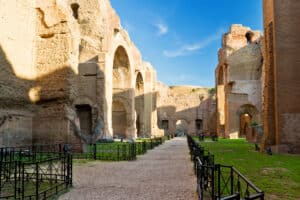
Baths of Caracalla, Rome, Italy.
The Baths of Caracalla were commissioned by Emperor Caracalla, also known as Marcus Aurelius Antoninus, in 212 AD. Construction continued under the rule of his successors, with the complex being inaugurated in 216 AD. It took nearly 9,000 workers and six years to complete the massive project.
The Baths of Caracalla were more than just a place to bathe; they were a symbol of Roman opulence, engineering prowess, and the empire’s social and cultural life. At its peak, the complex could accommodate around 8,000 visitors daily, making it one of the largest and most popular public baths in Rome.
The Baths of Caracalla fell into disuse after the fall of the Roman Empire. The site was later rediscovered in the 16th century, and since then, it has become a popular tourist attraction and an invaluable source of information on ancient Roman architecture and society.
Design and Architecture
The Baths of Caracalla spanned an area of about 25 hectares (62 acres) and featured a symmetrical design. The main building was surrounded by a large garden, with the bathing facilities at its center. Other structures, such as libraries, lecture halls, and shops, were also found within the complex.
The structure was primarily built using brick and concrete, with marble and other stones used for decorative purposes. The walls and floors were adorned with intricate mosaics, frescoes, and sculptures, showcasing the finest artistry of the time.
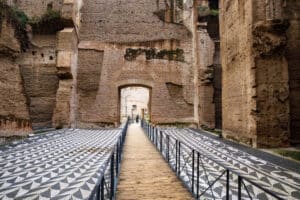
The Baths of Caracalla employed an advanced heating and water supply system, known as hypocaust. The floors were elevated on columns, creating a space for hot air to circulate and heat the rooms. Water was supplied by a dedicated aqueduct, the Aqua Marcia, and was heated in large furnaces before being distributed throughout the complex.
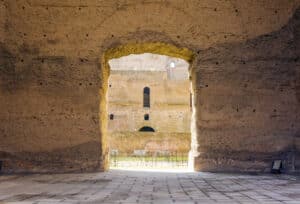
This image was purchased from Dreamstime.com with payment of the copyright fee. ID 96101839 | Baths Of Caracalla © Valerio Rosati | Dreamstime.com
Features of the Baths
Caldarium: The caldarium was the hot room in the bathing complex. It featured large marble-lined pools filled with hot water, where bathers could soak and relax. The room was heated using the hypocaust system, ensuring a consistently high temperature.
Tepidarium: The tepidarium was a warm room situated between the caldarium and the frigidarium. It was used as a transitional space for bathers to adjust their body temperature between the hot and cold rooms. The tepidarium also had heated benches for relaxation and socialization.
Frigidarium: The frigidarium was the cold room of the Baths, featuring large, cold-water basins. After sweating in the hot rooms, bathers would plunge into the cold water to invigorate their bodies and close their pores. This contrast in temperatures was believed to have various health benefits.
Natatio: The natatio was an enormous, open-air swimming pool located within the Baths of Caracalla. Surrounded by marble columns and statues, it was an impressive and luxurious space for visitors to swim and socialize.
Palestra: The palestra was an outdoor exercise area where visitors could engage in various physical activities, such as wrestling, boxing, and ball games. These exercises were an essential part of the bathing ritual, as they prepared the body for the thermal treatments.
Other Facilities: In addition to the bathing areas, the Baths of Caracalla also housed libraries, lecture halls, and shops. These facilities provided visitors with opportunities for intellectual pursuits and leisure activities while they enjoyed the baths.
Legacy and Influence
The Baths of Caracalla were a testament to ancient Roman engineering and artistic achievements. The complex inspired the design of many subsequent public baths across the Roman Empire and has been studied extensively by architects and historians. The Baths have also influenced modern spa design, as they represent a timeless model of well-being, relaxation, and social interaction.
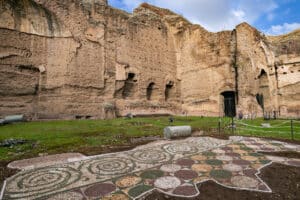
Terme di Caracalla
Today, the Baths of Caracalla are a popular tourist destination, offering a glimpse into the opulent world of ancient Rome. The site is managed by the Italian Ministry of Cultural Heritage and Activities and can be easily reached by public transport from Rome’s city center. Guided tours are available, providing visitors with a deeper understanding of the site’s history and architectural significance.
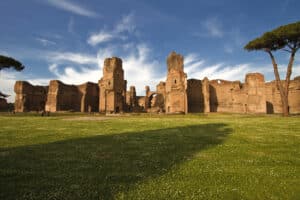
Terme di Caracalla (Baths of Carcalla) in Rome, Italy

